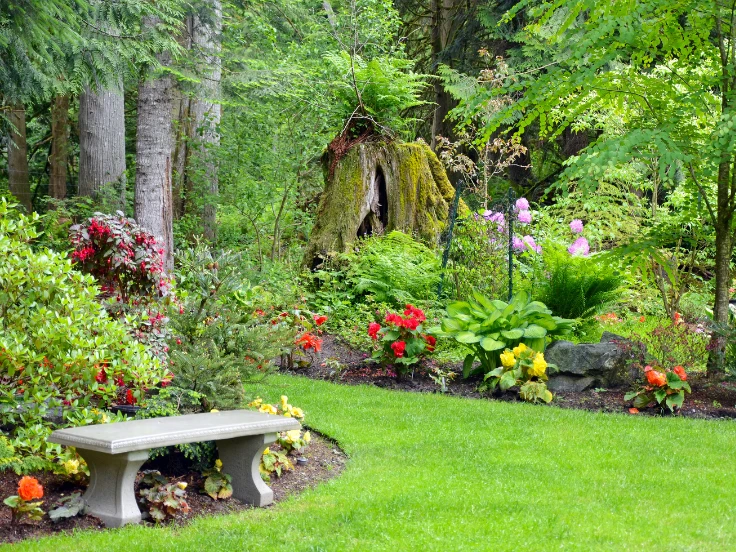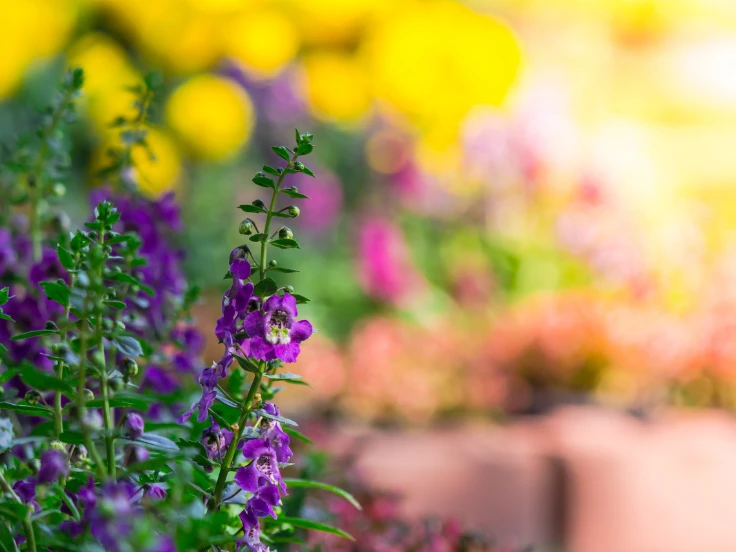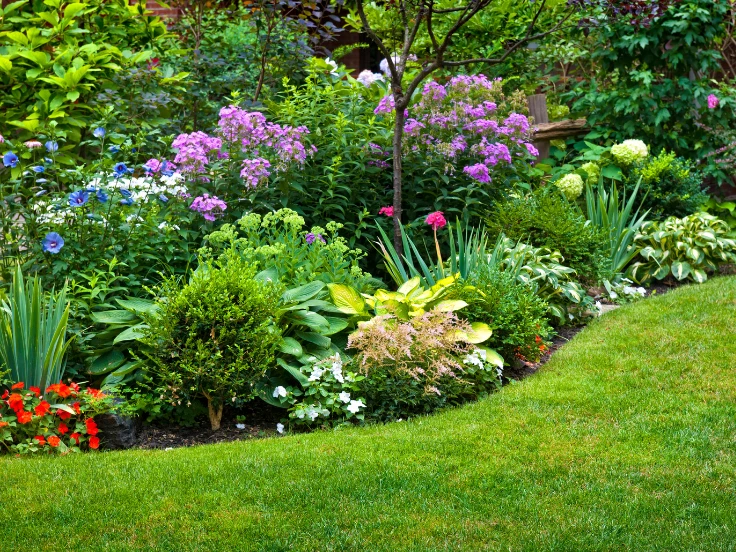Creating a garden that blooms year after year can seem challenging; however, a carefully selected perennial garden flowers list makes it much easier. Unlike annuals, perennials return season after season, providing continuous color, texture, and ecological benefits. Moreover, they save time and effort, making gardening more enjoyable.
In this guide, we will explore a comprehensive perennial garden flowers list, including sun-loving, shade-tolerant, pollinator-friendly, low-maintenance, and late-blooming perennials. Additionally, you will find planting tips, care instructions, and design strategies to ensure your garden thrives all year long.
Best Perennials for Full Sun

Full sun areas receive at least six hours of direct sunlight daily, making them perfect for perennials that thrive in bright conditions. Choosing the right sun-loving perennials ensures vibrant blooms, healthy growth, and long-lasting beauty throughout the growing season. These plants not only enhance your garden’s color but also attract pollinators and provide structure to sunny garden beds.
Coneflower (Echinacea purpurea)
Coneflowers (Echinacea purpurea) have large, daisy-like petals with a prominent central cone. In addition, they attract bees and butterflies, while being drought-tolerant. Blooming from midsummer to fall, they bring long-lasting color to sunny borders.
Black-eyed Susan (Rudbeckia hirta)
Black-eyed Susans brighten sunny spots with golden-yellow petals and dark centers. Moreover, they are heat-tolerant and low-maintenance. Pair them with purple coneflowers for a visually striking contrast.
Shasta Daisy (Leucanthemum × superbum)
Shasta daisies offer timeless beauty with white petals and yellow centers. They thrive in full sun and create a charming cottage-garden atmosphere. Additionally, they attract pollinators, enhancing your garden’s ecosystem.
Lavender (Lavandula spp.)
Lavender (Lavandula spp.) prefers sunny, well-drained soil. Furthermore, its fragrant blooms attract bees, butterflies, and hummingbirds. Lavender works beautifully in borders, herb gardens, or containers.
Salvia (Salvia nemorosa)
Salvias produce spikes of purple, blue, or pink flowers. Moreover, they are heat-tolerant, drought-resistant, and attract hummingbirds, adding color and movement to your sunny garden spaces.
Perennial Garden Flowers List for Partial Shade

Partial shade gardens receive filtered sunlight or only a few hours of direct sun each day. Choosing the right perennials for these conditions ensures healthy growth, vibrant foliage, and seasonal blooms even in less sunny spots. These shade-tolerant plants add texture, color, and depth to garden areas that might otherwise look bare.
Astilbe (Astilbe spp.)
Astilbes produce feathery plumes in shades of pink, red, or white. In addition, they prefer moist, shaded areas and bring softness and height to garden beds.
Hosta (Hosta spp.)
Hostas are known for their lush, textured foliage in green, blue, or variegated patterns. Moreover, they occasionally bloom lavender flowers, adding subtle charm to shaded borders.
Japanese Painted Fern (Athyrium niponicum)
Japanese Painted Fern (Athyrium niponicum) is a striking perennial with silvery-blue fronds and hints of red along the stems. Additionally, it thrives in partial to full shade and moist, well-drained soil, making it perfect for shaded garden beds. This deer-resistant fern adds elegance and texture to your perennial garden flowers list.
Heuchera (Coral Bells)
Coral Bells, or Heuchera, provide vibrant red, purple, and silver leaves. Additionally, they produce small bell-shaped flowers that attract pollinators, making them ideal for partial shade.
Bleeding Heart (Dicentra spectabilis)
Bleeding Heart (Dicentra spectabilis) produces delicate heart-shaped flowers in pink or white. Moreover, it prefers moist, fertile soil and adds a romantic touch to shaded borders.
Pollinator: Friendly Perennial Garden Flowers List
Supporting pollinators is essential for a healthy garden. Therefore, including these perennials ensures bees, butterflies, and hummingbirds visit your garden regularly.
Bee Balm: Attract Pollinators with the Perennial Garden Flowers List
Bee Balm (Monarda didyma) produces bright red, pink, or purple blooms. Additionally, it attracts bees, butterflies, and hummingbirds, making it a pollinator-friendly choice.
Lupine: Colorful Pollinator-Friendly Perennials in the Garden Flowers List
Tall lupine spikes enrich soil by fixing nitrogen. Furthermore, their blue, purple, or pink flowers attract pollinators and brighten garden borders.
Milkweed (Asclepias spp.)
Milkweed supports monarch butterflies with clusters of orange or pink blooms. Moreover, it thrives in full sun and well-drained soil, making it a vital plant for pollinator gardens.
Butterfly Bush (Buddleia davidii)
Buddleia davidii produces fragrant spikes of purple, pink, or white flowers. Additionally, it attracts butterflies throughout the summer months, extending garden activity.
Sedum (Sedum spectabile)
Sedums bloom in late summer with pink or red clusters. Furthermore, they draw pollinators like bees and butterflies, ensuring your garden remains lively into autumn.
Low-Maintenance Perennial Garden Flowers List

Low-maintenance perennials are perfect for gardeners who want beauty without constant care. These hardy plants thrive in a variety of conditions, requiring minimal watering, pruning, or fertilizing. Additionally, they provide long-lasting blooms and structure, making your garden look vibrant with less effort. For a complete guide on different flowers you can include in your garden, check out our detailed list of 100 types of flowers to find inspiration for combining perennials with other stunning blooms.
Daylily: Easy-Care Options in the Perennial Garden Flowers List
Daylilies (Hemerocallis spp.) produce abundant blooms from early summer to fall. Moreover, they are adaptable to most soil types and require minimal maintenance.
Coreopsis: Drought-Tolerant Favorites in Your Garden Flowers List
Coreopsis or Tickseed features bright yellow or red flowers. Furthermore, it tolerates drought and blooms profusely, adding long-lasting color.
Sedum: Succulent Perennials from the Perennial Garden Flowers List
Stonecrop stores water in its leaves, making it drought-tolerant. Additionally, it thrives in poor soil conditions and blooms in late summer to fall.
Blanket Flower: Heat-Resistant Perennials in the Garden Flowers List
Gaillardia produces long-lasting blooms in red, yellow, or orange. Moreover, it tolerates heat and poor soil, making it perfect for low-maintenance gardens.
Yarrow (Achillea millefolium)
Yarrow features flat clusters of white, yellow, or red flowers. In addition, it is deer-resistant and attracts pollinators, making it a versatile garden choice.
Late-Season Bloomers in the Perennial Garden Flowers List
Late-season bloomers extend your garden’s color and interest well into autumn. These perennials provide vibrant flowers when many other plants are fading, attracting pollinators and adding seasonal charm. For a truly harmonious garden, consider pairing these perennials with classic favorites like roses you can explore what flowers to plant with roses here. Incorporating them ensures your garden remains lively, colorful, and visually appealing throughout the end of the growing season.
Aster (Aster spp.)
Asters bloom from late summer to fall with purple, pink, or white flowers. Moreover, they attract bees and butterflies, keeping your garden active in autumn.
Russian Sage: Airy Perennials for Late Season in the Garden Flowers List
Russian Sage (Perovskia atriplicifolia) features silvery foliage and lavender-blue flowers. Additionally, it is drought-tolerant and adds airy texture to your garden beds.
Gaura: Wispy, Long-Blooming Perennials in the Garden Flowers List
Gaura (Oenothera lindheimeri) produces delicate flowers from spring until first frost. Furthermore, its tall, wispy stems create a graceful, flowing effect.
Helenium: Vibrant Late-Blooming Perennials in the Garden Flowers List
Sneezeweed blooms in yellow, orange, or red flowers during late summer. Moreover, it adds vibrant color to borders and cutting gardens.
Sedum ‘Autumn Joy’
This sedum variety blooms rosy-pink from late summer to fall. Additionally, it attracts pollinators and can be used in dried arrangements for winter. Learn more at The Spruce.
Planting and Care Tips for Your Perennial Garden Flowers List
-
Soil Preparation: Enrich soil with compost for nutrients and proper drainage. Furthermore, well-prepared soil promotes healthier roots.
-
Watering: Deeply water once a week. Moreover, avoid shallow, frequent watering, which can weaken roots.
-
Mulching: Retain moisture, reduce weeds, and protect roots. In addition, mulch helps regulate soil temperature.
-
Deadheading: Remove spent blooms to encourage continuous flowering. Additionally, it keeps the garden tidy.
-
Dividing Plants: Divide crowded perennials every 2–3 years to maintain plant health. Furthermore, it encourages more vigorous blooms.
FAQs
When is the Best Time to Plant Perennials?
Spring or fall allows roots to establish before extreme weather. Additionally, these seasons reduce transplant shock.
How Do I Care for Newly Planted Perennials?
Water consistently, mulch to retain moisture, and fertilize in early spring. Furthermore, keep an eye on weeds to ensure healthy growth.
Can Perennials Grow in Containers?
Yes, use containers with drainage and quality potting soil. Moreover, place them where sunlight matches the plant’s needs.
Which Perennials Are Deer-Resistant?
Yarrow, Sedum, Russian Sage, and Japanese Painted Fern are excellent options. In addition, planting a mix can further deter deer.
How Can I Attract Pollinators Using Perennials?
Plant nectar-rich flowers, provide water, and avoid pesticides. Moreover, choose a variety of bloom times to keep pollinators visiting throughout the season.
Conclusion: Create a Thriving Perennial Garden
Perennial flowers offer sustainable, low-maintenance beauty year-round. Therefore, selecting plants based on sunlight, bloom times, and care requirements ensures continuous color and attracts pollinators. Additionally, following this perennial garden flowers list helps gardeners design a harmonious, vibrant, and eco-friendly landscape that thrives season after season.
Moreover, incorporating a variety of perennials with different heights, colors, and textures creates visual interest throughout the year. Not only do these plants enhance the garden’s aesthetic appeal, but they also support local wildlife and improve soil health. Finally, with proper planning and care, gardeners can enjoy a beautiful, resilient garden that requires minimal effort while providing maximum rewards.


















